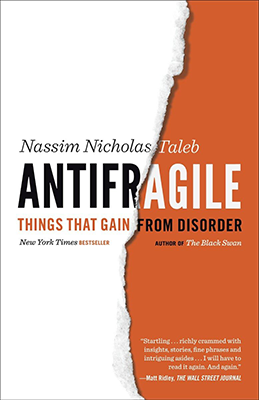Antifragile
“Antifragile: Things That Gain from Disorder” by Nassim Nicholas Taleb is a book that explores the concept of antifragility—the ability of certain systems to thrive and benefit from volatility, uncertainty, and randomness. Here’s a summary of its key points:
Antifragility vs. Fragility: Taleb contrasts antifragility with fragility and robustness, arguing that while fragile systems are vulnerable to shocks and disruptions, antifragile systems actually improve and grow stronger in the face of adversity. He explains how antifragility can be observed in various domains, from biology and economics to technology and culture.
The Lindy Effect: Taleb introduces the Lindy effect, which suggests that the longer something has survived, the longer it can be expected to survive in the future. He argues that antifragile systems tend to have a longer lifespan and are more resistant to extinction, while fragile systems are more susceptible to collapse.
Barbell Strategy: Taleb discusses the barbell strategy—a risk management approach that involves balancing exposure to extreme risks and extreme opportunities. He argues that this strategy can help individuals and organizations benefit from uncertainty and capitalize on positive Black Swan events, while minimizing downside risk.
Skin in the Game: Taleb emphasizes the importance of “skin in the game”—having a personal stake or exposure to the consequences of one’s decisions. He argues that skin in the game aligns incentives, promotes accountability, and reduces the likelihood of reckless behavior.
Decentralization and Redundancy: The book explores the benefits of decentralization and redundancy in promoting antifragility. Taleb argues that distributed systems are more resilient to failures and disruptions, as they are less reliant on single points of failure.
Trial and Error: Taleb discusses the role of trial and error in promoting antifragility. He argues that experimentation, adaptation, and learning from mistakes are essential for building resilience and improving performance over time.
Stoicism and Resilience: The book draws on principles from Stoic philosophy to promote emotional resilience and equanimity in the face of adversity. Taleb discusses the importance of accepting uncertainty and embracing volatility as inevitable aspects of life.
Implications for Policy and Society: Taleb concludes with implications for policy-making, economics, and society. He argues that embracing antifragility requires humility, flexibility, and a willingness to tolerate decentralized experimentation and diversity of opinion.
Overall, “Antifragile” offers a provocative and thought-provoking exploration of resilience, uncertainty, and the benefits of embracing disorder. Whether you’re a business leader, investor, policymaker, or simply interested in understanding the dynamics of complex systems, Taleb’s insights can help you navigate uncertainty and build more antifragile systems and organizations.

